Phytosterol–γ-Oryzanol–Glycerol Monostearate Composite Gelators for Palm Stearin/Linseed Oil Oleogel-Based Margarine: Nutrient Enrichment, Textural Modulation, and Commercial Product Mimicry
Abstract
:1. Introduction
2. Materials and Methods
2.1. Materials and Chemicals
2.2. Preparation of Oleogel
2.3. Preparation of Margarine
2.4. Texture Properties
2.5. Rheological Properties
2.6. Appearance and Microstructure
2.7. Polymorphism
2.8. Thermal Analysis
2.9. Solid Fat Content
2.10. Fatty Acid Composition
2.11. Statistical Analysis
3. Results and Discussion
3.1. Fatty Acid Composition of Oleogel-Based Margarine
3.2. Texture Properties of Oleogel-Based Margarine
3.3. Rheological Property of Oleogel-Based Margarine
3.4. Appearance and Microstructure of Oleogel-Based Margarine
3.5. Polymorphism of Oleogel-Based Margarine
3.6. Melting Property of Oleogel-Based Margarine
4. Conclusions
Author Contributions
Funding
Institutional Review Board Statement
Informed Consent Statement
Data Availability Statement
Conflicts of Interest
Abbreviations
| PST/LO-BM | Palm stearin/linseed oil-based margarine |
| PST/LO-OBM | Palm stearin/linseed oil oleogel-based margarine |
| CM | Commercial margarine |
| PO | Phytosterol–γ-oryzanol |
| GMS | Glycerol monostearate |
| TAG | Triglyceride |
Appendix A

References
- Chai, X.; Zhang, Y.; Shi, Y.; Liu, Y. Crystallization and Structural Properties of Oleogel-Based Margarine. Molecules 2022, 27, 8952. [Google Scholar] [CrossRef]
- Silva, T.J.; Barrera-Arellano, D.; Ribeiro, A.P.B. Margarines: Historical approach, technological aspects, nutritional profile, and global trends. Food Res. Int. 2021, 147, 110486. [Google Scholar] [CrossRef]
- Li, C.; Cobb, L.K.; Vesper, H.W.; Asma, S. Global Surveillance of trans-Fatty Acids. Prev. Chronic Dis. 2019, 16, E147. [Google Scholar] [CrossRef]
- Tan, B.L.; Norhaizan, M.E. Excessive Consumption of Fats and Cardiovascular Disease. In Nutrients and Oxidative Stress: Biochemistry Aspects and Pharmacological Insights; Tan, B.L., Norhaizan, M.E., Eds.; Springer Nature: Cham, Switzerland, 2024; pp. 59–68. [Google Scholar]
- Manzoor, S.; Masoodi, F.A.; Naqash, F.; Rashid, R. Oleogels: Promising alternatives to solid fats for food applications. Food Hydrocoll. Health 2022, 2, 100058. [Google Scholar] [CrossRef]
- Park, C.; Maleky, F. A Critical Review of the Last 10 Years of Oleogels in Food. Front. Sustain. Food Syst. 2020, 4, 139. [Google Scholar] [CrossRef]
- Loza-Rodríguez, N.; Millán-Sánchez, A.; López, O. A biocompatible lipid-based bigel for topical applications. Eur. J. Pharm. Biopharm. 2023, 190, 24–34. [Google Scholar] [CrossRef]
- Wang, Y.; Liu, S.; Zhang, L.; Nagib, A.; Li, Q.; Geng, R.; Yu, X.; Xu, T.; Zhang, S.; Duan, R.; et al. Formation, characterization, and application of natural bioactive phytosterol-based oleogels: A review. Food Chem. 2024, 454, 139821. [Google Scholar] [CrossRef]
- Palla, C.A.; Dominguez, M.; Carrín, M.E. Recent advances on food-based applications of monoglyceride oleogels. J. Am. Oil Chem. Soc. 2022, 99, 985–1006. [Google Scholar] [CrossRef]
- Mohamad, R.; Agus, B.A.P.; Hussain, N. Changes of Phytosterols, Rheology, Antioxidant Activity and Emulsion Stability of Salad Dressing with Cocoa Butter During Storage. Food Technol. Biotechnol. 2019, 57, 59–67. [Google Scholar] [CrossRef]
- Shuai, X.; Li, Y.; Zhang, M.; Wei, C.; Du, L.; Liu, C.; Chen, J.; Dai, T. Effect of different oleogelation mechanisms on physical properties and oxidative stability of macadamia oil-based oleogels and its application. LWT 2024, 198, 115978. [Google Scholar] [CrossRef]
- Hwang, H.-S.; Kim, S.; Winkler-Moser, J.; Lee, S.; Liu, S. Feasibility of Hemp Seed Oil Oleogels Structured with Natural Wax as Solid Fat Replacement in Margarine. J. Am. Oil Chem. Soc. 2022, 99, 1055–1070. [Google Scholar] [CrossRef]
- Hwang, H.S.; Winkler-Moser, J.K. Properties of margarines prepared from soybean oil oleogels with mixtures of candelilla wax and beeswax. J. Food Sci. 2020, 85, 3293–3302. [Google Scholar] [CrossRef]
- Zulfiqar, A.; Shabbir, M.A.; Tahir, F.; Khan, M.R.; Ahmed, W.; Yıkmış, S.; Manzoor, M.F.; Abdi, G.; Aadil, R.M. Development of oleogel by structuring the blend of corn oil and sunflower oil with beeswax to replace margarine in cookies. Food Chem. X 2024, 23, 101676. [Google Scholar] [CrossRef]
- Tang, Z.; Ying, R.-F.; Lv, B.-F.; Yang, L.-H.; Xu, Z.; Yan, L.-Q.; Bu, J.-Z.; Wei, Y.-S. Flaxseed oil: Extraction, Health benefits and products. Qual. Assur. Saf. Crop. Foods 2021, 13, 1–19. [Google Scholar] [CrossRef]
- Zhang, M.; Xu, B.; Zhao, D.; Shen, M.; Li, M.; Liu, D.; Liu, L. Production of Margarine Fat Containing Medium- and Long-Chain Triacylglycerols by Enzymatic Interesterification of Peony Seed Oil, Palm Stearin and Coconut Oil Blends. Foods 2024, 13, 1405. [Google Scholar] [CrossRef]
- Wang, Y.; Liu, B.; Hu, Y.; Sampson, L.; Manson, J.E.; Rimm, E.B.; Sun, Q. Phytosterol intake and risk of coronary artery disease: Results from 3 prospective cohort studies. Am. J. Clin. Nutr. 2024, 119, 344–353. [Google Scholar] [CrossRef]
- Zio, S.; Tarnagda, B.; Tapsoba, F.; Zongo, C.; Savadogo, A. Health interest of cholesterol and phytosterols and their contribution to one health approach: Review. Heliyon 2024, 10, e40132. [Google Scholar] [CrossRef]
- Qiao, W.; Feng, H.; Zhang, Y.F.; Zhang, Z.; Yang, J.; Wu, M.; Xie, J.; Huang, J.; Zhou, T.; Zhang, Y. Protective association between dietary phytosterol intake and cardiovascular health: An analysis of the UK Biobank cohort. Food Funct 2025, 16, 1157–1168. [Google Scholar] [CrossRef]
- GB 5009.168; The Chinese Food Safety Standards, Standards for Determination of Fatty Acid. National Health and Family Planning Commission of the PRC: Beijing, China, 2016.
- Yang, D.; Lee, Y.Y.; Lu, Y.; Wang, Y.; Zhang, Z. Internal Factors Affecting the Crystallization of the Lipid System: Triacylglycerol Structure, Composition, and Minor Components. Molecules 2024, 29, 1847. [Google Scholar] [CrossRef]
- Zhang, Z.; Ye, J.; Lee, W.J.; Akoh, C.C.; Li, A.; Wang, Y. Modification of palm-based oil blend via interesterification: Physicochemical properties, crystallization behaviors and oxidative stabilities. Food Chem 2021, 347, 129070. [Google Scholar] [CrossRef]
- Liu, P.; Huang, L.; Liu, T.; Cai, Y.; Zeng, D.; Zhou, F.; Zhao, M.; Deng, X.; Zhao, Q. Whipping properties and stability of whipping cream: The impact of fatty acid composition and crystallization properties. Food Chem. 2021, 347, 128997. [Google Scholar] [CrossRef]
- Su, R.; Liu, X.; Sun-Waterhouse, D.; Wang, W.; Wang, Y. Enzymatic Interesterification of Palm Stearin, Flaxseed Oil and Cottonseed Stearin to Produce Stable Plastic Fat with Balanced Omega-6 and Omega-3 Fatty Acids. J. Oleo Sci. 2023, 72, 799–810. [Google Scholar] [CrossRef]
- Smet, K.; Coudijzer, K.; Fredrick, E.; De Campeneere, S.; De Block, J.; Wouters, J.; Raes, K.; Dewettinck, K. Crystallization behavior of milk fat obtained from linseed-fed cows. J. Dairy Sci. 2010, 93, 495–505. [Google Scholar] [CrossRef]
- Fallahasgari, M.; Barzegar, F.; Abolghasem, D.; Nayebzadeh, K. An overview focusing on modification of margarine rheological and textural properties for improving physical quality. Eur. Food Res. Technol. 2023, 249, 2227–2240. [Google Scholar] [CrossRef]
- Liu, C.; Zheng, Z.; Meng, Z.; Chai, X.; Cao, C.; Liu, Y. Beeswax and carnauba wax modulate the crystallization behavior of palm kernel stearin. LWT 2019, 115, 108446. [Google Scholar] [CrossRef]
- Rondou, K.; Romanus, M.; Verwee, E.; Penagos, I.A.; De Witte, F.; Skirtach, A.G.; Dewettinck, K.; Van Bockstaele, F. Crystallization Behavior and Structural Build-Up of Palm Stearin—Wax Hybrid Fat Blends. Food Biophys. 2024, 19, 1042–1052. [Google Scholar] [CrossRef]
- Hu, J.; Gao, Y.; Lu, Q.; Jiang, Y.; Jin, H.; Li, Q.; Yu, X. Development and evaluation of a novel margarine using starch hydrogel combined edible wax oleogel bigels. J. Food Eng. 2024, 388, 112360. [Google Scholar] [CrossRef]
- Ukkunda, N.S.; Santhoshkumar, P.; Moses, J.A. Impact of different natural sweeteners on 3D printability and post-printing quality of marzipan. Futur. Foods 2025, 11, 100557. [Google Scholar] [CrossRef]
- Alkabaa, A.S.; Akcicek, A.; Taylan, O.; Balubaid, M.; Alamoudi, M.; Gulzar, W.A.; Alidrisi, H.; Dertli, E.; Karasu, S. Production of Novel Bigels from Cold Pressed Chia Seed Oil By-Product: Application in Low-Fat Mayonnaise. Foods 2024, 13, 574. [Google Scholar] [CrossRef]
- Dadali, C.; Elmacı, Y. Influence of Fat and Emulsifier Content on Volatile Release of Butter Aroma Used in Water Phase and Physical Attributes of Model Margarines. Eur. J. Lipid Sci. Technol. 2020, 122, 2000036. [Google Scholar] [CrossRef]
- Sun, M.; Wang, C.; Wang, H.; Tan, M. Fish oil-based bigels with outstanding sensory and antioxidant properties: Application in low-fat mayonnaise. Food Hydrocoll. 2024, 159, 110673. [Google Scholar] [CrossRef]
- Zare, M.; Golmakani, M.-T.; Niakousari, M.; Eskandari, M.H.; Ghiasi, F.; Hosseini, S.M.H. Alginate/whey protein isolate-based emulgel as an alternative margarine replacer in processed cheese: Impact on rheological, mechanical, nutritional, and sensory characteristics. J. Dairy Sci. 2024, 107, 4308–4319. [Google Scholar] [CrossRef]
- Liu, D.; Xu, B.; Zhao, D.; Ma, Q.; Li, J.; Amjad, M.U.; Ding, Y.; Liu, L. Construction and application of a novel bigel system to prepare a nutritional cream. LWT 2024, 198, 116000. [Google Scholar] [CrossRef]
- Liu, L.; Li, L.; Wan, L.; Mao, L.; Li, B.; Zhang, X. Addition of glyceryl monostearate affects the crystallization behavior and polymorphism of palm stearin. Bioprocess Biosyst. Eng. 2019, 44, 941–949. [Google Scholar] [CrossRef]
- Rogers, M.A.; Bot, A.; Lam, R.S.H.; Pedersen, T.; May, T. Multicomponent Hollow Tubules Formed Using Phytosterol and γ-Oryzanol-Based Compounds: An Understanding of Their Molecular Embrace. J. Phys. Chem. A 2010, 114, 8278–8285. [Google Scholar] [CrossRef]
- Stahl, M.A.; Buscato, M.H.M.; Grimaldi, R.; Cardoso, L.P.; Ribeiro, A.P.B. Structuration of lipid bases with fully hydrogenated crambe oil and sorbitan monostearate for obtaining zero-trans/low sat fats. Food Res. Int. 2018, 107, 61–72. [Google Scholar] [CrossRef]
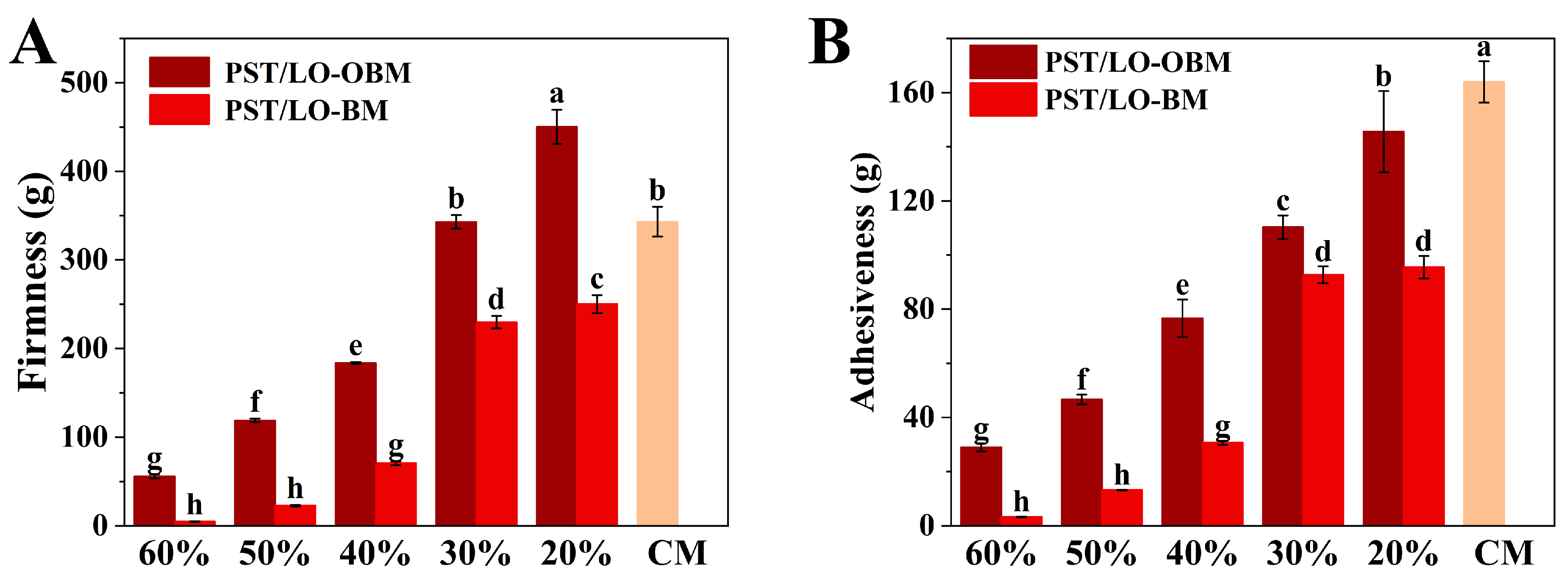
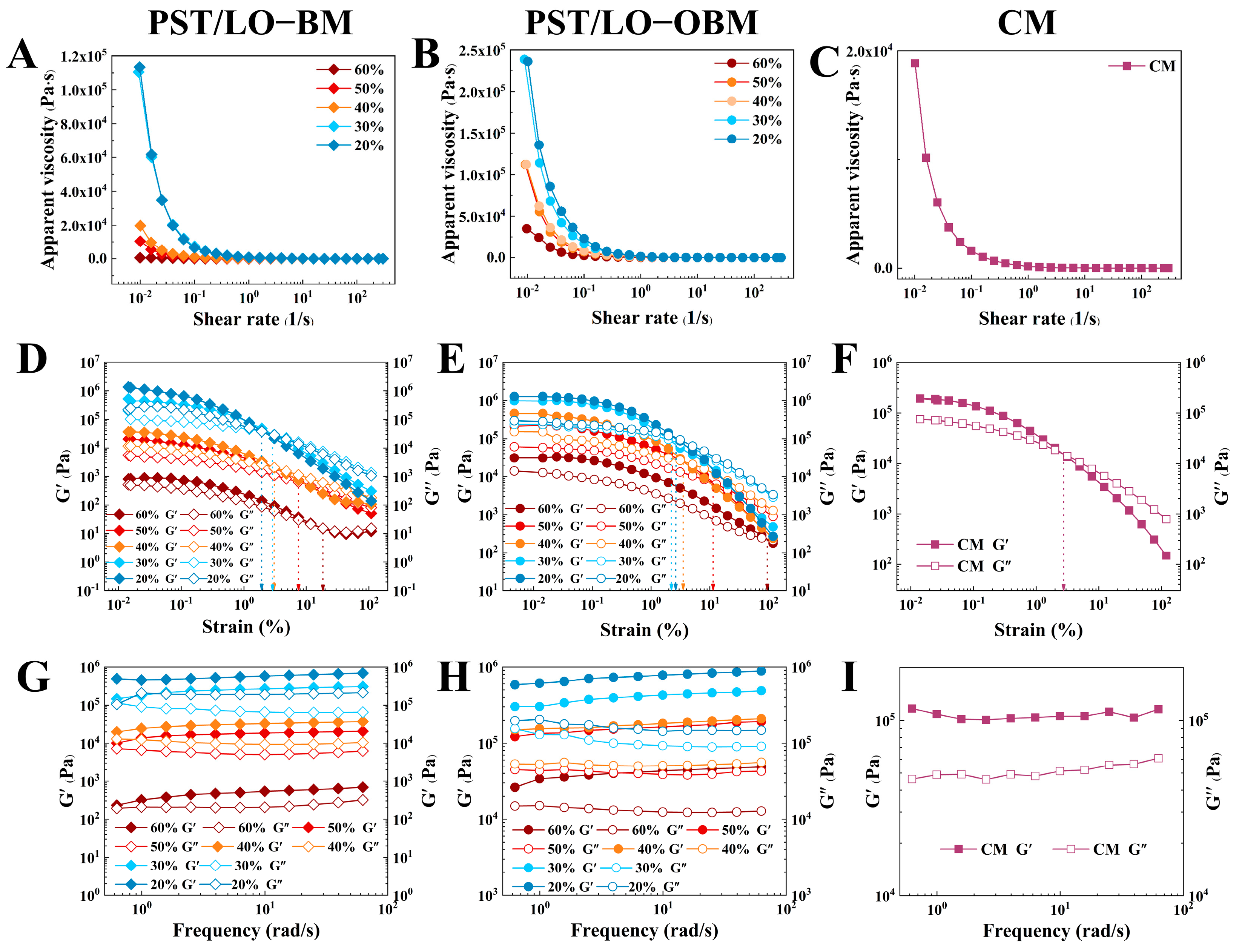
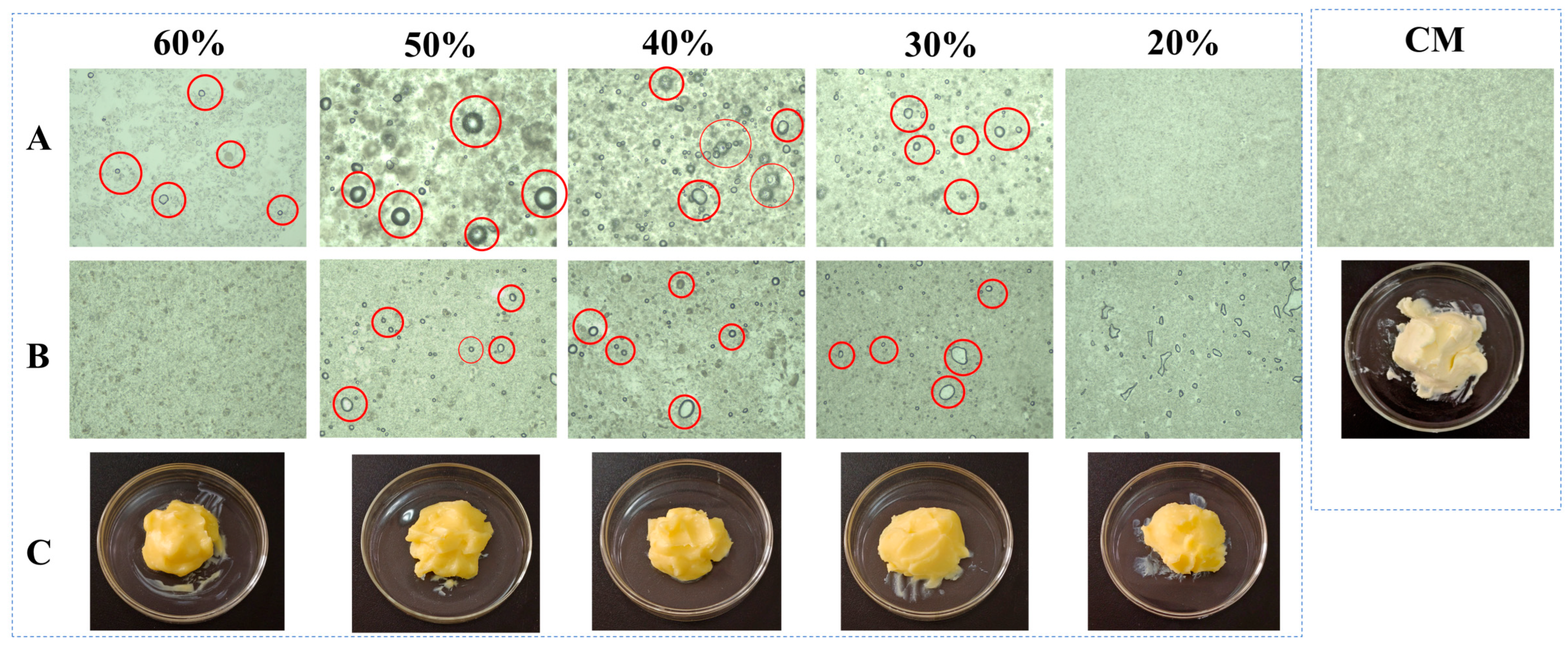
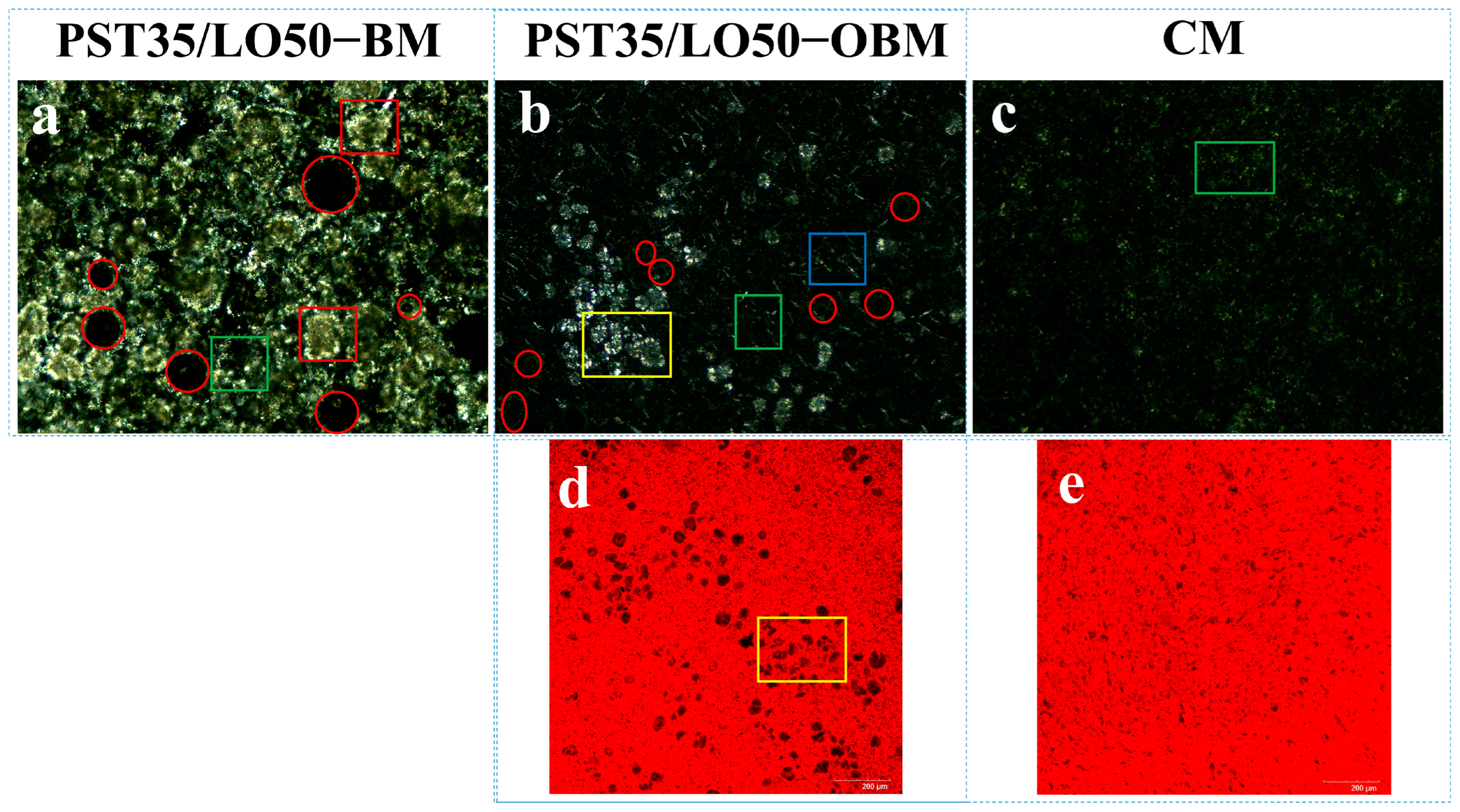

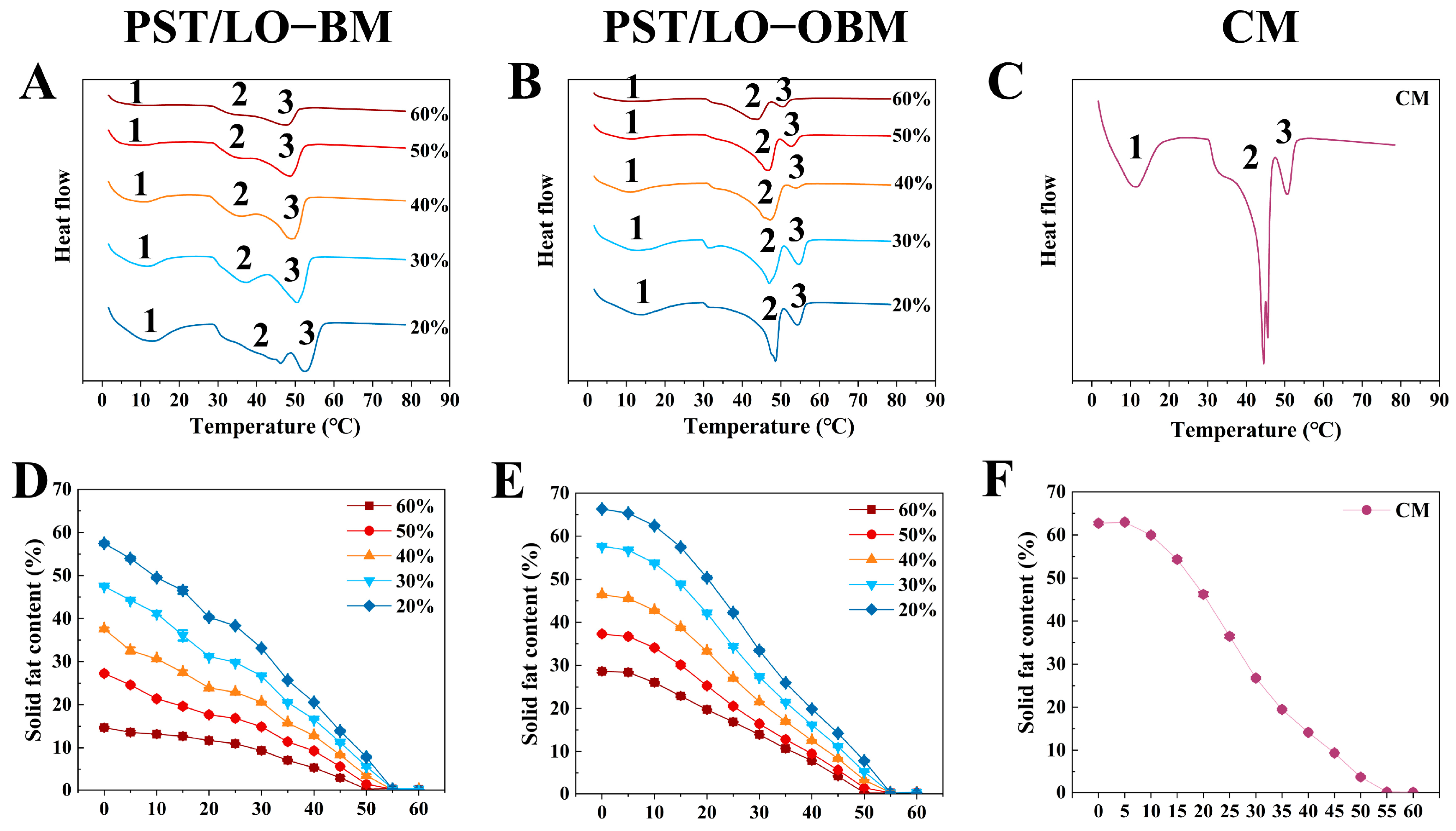
| Margarine | Sample | Oil Phase (wt%) | Aqueous Phase (wt%) | |||||||
|---|---|---|---|---|---|---|---|---|---|---|
| PST | LO | Soy Lecithin | GMS | PS | γ-Oryzanol | Water | Skimmed Milk Powder | Salt | ||
| PST/LO-BM | PST65/LO20-BM | 65 | 20 | 0.3 | - | - | - | 12.5 | 2.0 | 0.2 |
| PST55/LO30-BM | 55 | 30 | 0.3 | - | - | - | 12.5 | 2.0 | 0.2 | |
| PST45/LO40-BM | 45 | 40 | 0.3 | - | - | - | 12.5 | 2.0 | 0.2 | |
| PST35/LO50-BM | 35 | 50 | 0.3 | - | - | - | 12.5 | 2.0 | 0.2 | |
| PST25/LO60-BM | 25 | 60 | 0.3 | - | - | - | 12.5 | 2.0 | 0.2 | |
| PST/LO-OBM | PST65/LO20-OBM | 65 | 17.8 | 0.3 | 0.44 | 0.70 | 1.06 | 12.5 | 2.0 | 0.2 |
| PST55/LO30-OBM | 55 | 26.7 | 0.3 | 0.66 | 1.06 | 1.58 | 12.5 | 2.0 | 0.2 | |
| PST45/LO40-OBM | 45 | 35.6 | 0.3 | 0.88 | 1.41 | 2.11 | 12.5 | 2.0 | 0.2 | |
| PST35/LO50-OBM | 35 | 44.5 | 0.3 | 1.10 | 1.76 | 2.64 | 12.5 | 2.0 | 0.2 | |
| PST25/LO60-OBM | 25 | 53.4 | 0.3 | 1.32 | 2.11 | 3.17 | 12.5 | 2.0 | 0.2 | |
| FA (%) | PST | LO | PST25/LO60 -OBM | PST35/LO50 -OBM | PST45/LO40 -OBM | PST55/LO30 -OBM | PST65/LO20 -OBM |
|---|---|---|---|---|---|---|---|
| C14:0 | 1.295 ± 0.003 a | 0.133 ± 0.005 e | 0.491 ± 0.113 d | 0.495 ± 0.067 d | 0.543 ± 0.015 d | 0.800 ± 0.005 c | 0.928 ± 0.023 b |
| C16:0 | 50.664 ± 0.724 a | 7.664 ± 0.228 g | 21.017 ± 0.586 f | 26.928 ± 0.202 e | 32.961 ± 0.924 d | 42.894 ± 0.454 c | 50.208 ± 0.226 b |
| C18:0 | 7.986 ± 0.239 a | 6.854 ± 0.641 b | 6.904 ± 0.422 b | 7.661 ± 0.520 ab | 7.044 ± 0.243 ab | 7.340 ± 0.007 ab | 6.722 ± 0.021 b |
| C18:1 | 31.151 ± 1.145 a | 22.591 ± 1.455 c | 22.709 ± 1.394 c | 23.524 ± 0.619 c | 26.077 ± 0.912 b | 26.413± 0.184 b | 29.218 ± 0.141 a |
| C18:2 | 7.938 ± 0.167 d | 19.183 ± 1.249 a | 15.734 ± 0.988 b | 12.646 ± 0.181 c | 11.604 ± 0.388 c | 8.792 ±0.106 d | 7.806 ± 0.064 d |
| C18:3 | 0.475 ± 0.011 g | 43.347 ± 3.547 a | 32.687 ± 0.551 b | 28.549 ± 0.001 c | 23.531 ± 0.17 d | 13.513 ± 0.160 e | 4.897 ± 0.052 f |
| C20:0 | 0.492 ± 0.023 a | 0.227 ± 0.021 b | 0.459 ± 0.164 a | 0.199 ± 0.012 b | 0.343 ± 0.026 ab | 0.248 ± 0.004 b | 0.221 ± 0.028 b |
| SFA | 60.437 ± 0.989 a | 15.184 ± 0.411 g | 28.871 ± 0.957 f | 35.505 ± 1.117 e | 40.891 ± 1.156 d | 51.282 ± 0.450 c | 58.079 ± 0.257 b |
| USFA | 39.563 ± 0.989 f | 85.121 ± 0.843 a | 71.129 ± 0.957 b | 64.495 ± 1.117 c | 61.211 ± 1.816 d | 48.718 ± 0.450 e | 41.921 ± 0.257 f |
| Samples | PST25/LO60-BM | PST35/LO50-BM | PST45/LO40-BM | PST55/LO30-BM | PST65/LO20-BM | |
|---|---|---|---|---|---|---|
| Peak 1 | To/°C | 1.74 ± 0.04 bc | 1.68 ± 0.04 c | 1.72 ± 0.01 c | 1.82 ± 0.02 ab | 1.86 ± 0.04 a |
| Tp/°C | 7.79 ± 0.35 b | 7.92 ± 0.71 b | 8.13 ± 1.00 b | 11.35 ± 1.10 a | 13.08 ± 0.39 a | |
| ΔH, J/g | 2.95 ± 0.43 d | 6.33 ± 0.29 c | 8.65 ± 0.07 c | 11.66 ± 2.23 b | 19.78 ± 1.31 a | |
| Peak 2 | To/°C | 28.38 ± 0.02 a | 28.33 ± 0.37 a | 28.35 ± 0.20 a | 28.76 ± 0.22 a | 29.02 ± 0.39 a |
| Tp/°C | 33.83 ± 0.49 c | 34.16 ± 0.02 c | 34.49 ± 0.38 c | 37.95 ± 1.09 b | 45.58 ± 1.50 a | |
| ΔH, J/g | 0.93 ± 0.07 d | 2.42 ± 0.21 cd | 4.38 ± 0.60 c | 8.21 ± 0.92 b | 10.77 ± 1.61 a | |
| Peak 3 | To/°C | 39.11 ± 0.30 d | 39.63 ± 0.47 d | 41.14 ± 0.06 c | 43.30 ± 0.54 b | 49.25 ± 0.59 a |
| Tp/°C | 48.06 ± 0.16 d | 48.68 ± 0.14 d | 49.72 ± 0.10 c | 50.71 ± 0.02 b | 53.11 ± 0.67 a | |
| ΔH J/g | 5.49 ± 0.05 d | 9.53 ± 0.35 b | 13.69 ± 0.81 a | 13.32 ± 0.08 a | 7.66 ± 0.55 c | |
| Samples | PST25/LO60-OBM | PST35/LO50-OBM | PST45/LO40-OBM | PST55/LO30-OBM | PST65/LO20-OBM | |
| Peak 1 | To/°C | 1.81 ± 0.13 a | 1.84 ± 0.18 a | 1.81 ± 0.13 a | 1.80 ± 0.04 a | 1.79 ± 0.03 a |
| Tp/°C | 9.44 ± 0.59 c | 10.86 ± 0.70 bc | 10.87 ± 0.58 bc | 12.06 ± 0.52 ab | 12.89 ± 1.17 a | |
| ΔH, J/g | 8.60 ± 0.39 d | 14.84 ± 0.23 c | 16.17 ± 0.21 c | 19.66 ± 1.92 b | 26.83 ± 2.39 a | |
| Peak 2 | To/°C | 33.20 ± 4.47 a | 30.52 ± 0.67 a | 32.75 ± 0.23 a | 33.29 ± 2.38 a | 36.08 ± 0.70 a |
| Tp/°C | 43.91 ± 0.42 a | 46.55 ± 0.12 b | 47.08 ± 0.24 ab | 46.81 ± 0.76 b | 48.24 ± 0.60 a | |
| ΔH, J/g | 16.60 ± 0.21 c | 22.98 ± 0.58 b | 24.68 ± 0.74 ab | 24.74 ± 0.83 ab | 26.71 ± 1.47 a | |
| Peak 3 | To/°C | 48.18 ± 0.12 d | 50.04 ± 0.14 c | 51.50 ± 0.02 a | 50.11 ± 0.18 c | 50.84 ± 0.01 b |
| Tp/°C | 50.85 ± 0.08 d | 52.62 ± 0.01 c | 54.05 ± 0.08 b | 54.12 ± 0.01 b | 54.55 ± 0.07 a | |
| ΔH J/g | 1.33± 0.03 bc | 2.43 ± 0.15 b | 0.68 ± 0.33 c | 8.18 ± 0.57 a | 7.22 ± 1.29 a | |
Disclaimer/Publisher’s Note: The statements, opinions and data contained in all publications are solely those of the individual author(s) and contributor(s) and not of MDPI and/or the editor(s). MDPI and/or the editor(s) disclaim responsibility for any injury to people or property resulting from any ideas, methods, instructions or products referred to in the content. |
© 2025 by the authors. Licensee MDPI, Basel, Switzerland. This article is an open access article distributed under the terms and conditions of the Creative Commons Attribution (CC BY) license (https://creativecommons.org/licenses/by/4.0/).
Share and Cite
Li, J.; Hu, Y.; Ma, Q.; Zhao, D.; Dou, X.; Xu, B.; Liu, L. Phytosterol–γ-Oryzanol–Glycerol Monostearate Composite Gelators for Palm Stearin/Linseed Oil Oleogel-Based Margarine: Nutrient Enrichment, Textural Modulation, and Commercial Product Mimicry. Foods 2025, 14, 1206. https://doi.org/10.3390/foods14071206
Li J, Hu Y, Ma Q, Zhao D, Dou X, Xu B, Liu L. Phytosterol–γ-Oryzanol–Glycerol Monostearate Composite Gelators for Palm Stearin/Linseed Oil Oleogel-Based Margarine: Nutrient Enrichment, Textural Modulation, and Commercial Product Mimicry. Foods. 2025; 14(7):1206. https://doi.org/10.3390/foods14071206
Chicago/Turabian StyleLi, Jingwen, Yujuan Hu, Qing Ma, Dongkun Zhao, Xinjing Dou, Baocheng Xu, and Lili Liu. 2025. "Phytosterol–γ-Oryzanol–Glycerol Monostearate Composite Gelators for Palm Stearin/Linseed Oil Oleogel-Based Margarine: Nutrient Enrichment, Textural Modulation, and Commercial Product Mimicry" Foods 14, no. 7: 1206. https://doi.org/10.3390/foods14071206
APA StyleLi, J., Hu, Y., Ma, Q., Zhao, D., Dou, X., Xu, B., & Liu, L. (2025). Phytosterol–γ-Oryzanol–Glycerol Monostearate Composite Gelators for Palm Stearin/Linseed Oil Oleogel-Based Margarine: Nutrient Enrichment, Textural Modulation, and Commercial Product Mimicry. Foods, 14(7), 1206. https://doi.org/10.3390/foods14071206






